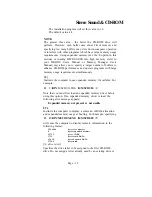
Stereo Sound & CD-ROM
Instructs the computer to display a summary of RAM allocation
and expanded memory usage at booting. For Example, specifying:
O C:\BIN\MSCDEXEXE /D:MSCD«00 /V
will cause the computer to display memory information in the
following format:
5556864 bytes free memory
0 bytes expanded memory
12752 bytes CODE
1712 bytes static DATA
12618 bytes dynamic DATA
27344 bytes used
[/Lulrive letter]
Specifies the drive letter to be assigned to the first CD-ROM
drive. Do not assign a letter already used by an existing drive or
the computer will be unable to access the CD-ROM drive. For
example, you might use:
O C: \B IN YM S C D EX. EX E /D:MSCD000 /L:f
Normally, the CD-ROM drive is assigned the next available drive
letter on the computer after the floppy drives, hard drives, RAM
drives, etc. Therefore you only need to use this option if it is
necessary to assign a drive letter beyond the last letter in use.
Step 3. Create two sub-directory
BIN & DEV
under the root
directory on your boot hard disk ( drive C in general). Copy
CDMKJLSYS
to the subdirectory BIN and
MSCDEX.EXE
to the subdirectory DEV from the subdirectory
\CDROM\MITSUMI
on the floppy diskette.
If you are installing the CD-ROM drive in a networked system,
please consult your system manager or system setup for proper
drive specifications in Step 1 to Step 3.
4.5.2 MITSUMI Audio Utility Installation
To install the audio utility, you may insert the diskette to the drive
that you selected. Then change to A or B drive, where the floppy
diskette is in, by entering the following command at the system
prompt:
O C:\>A: lEnter]
Page - 23
















